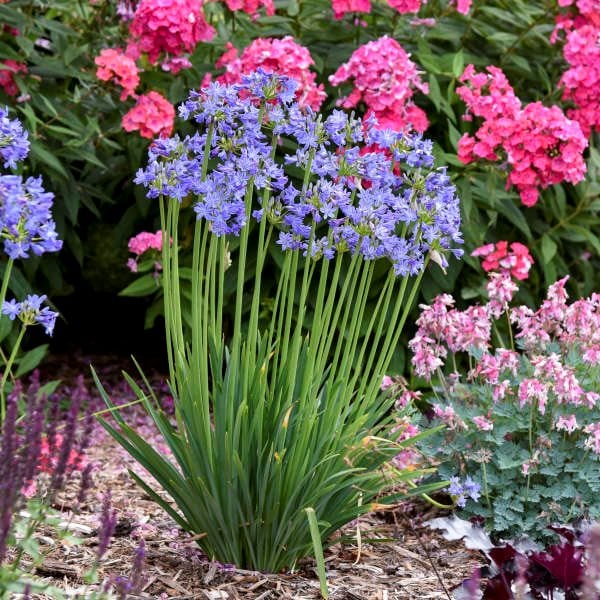Growing Agapanthus: A Total Guide to Beautiful Blooms
Growing Agapanthus: A Total Guide to Beautiful Blooms
Blog Article
Mastering the Art of Agapanthus Care: Necessary Steps for Healthy Development and Vibrant Blossoms
In the realm of horticulture, the growing of agapanthus stands as a fulfilling venture for those who seek to support these elegant flowering plants. With their striking blossoms and graceful foliage, agapanthus has actually captured the focus of garden enthusiasts worldwide. Nevertheless, attaining optimal growth and vibrant blossoms needs a nuanced technique that includes different necessary actions. From choosing the best variety to understanding trimming methods, the trip towards cultivating flourishing agapanthus plants is complex and holds the vital to unlocking the full possibility of these agricultural treasures.

Picking the Right Agapanthus Range

When choosing the right Agapanthus range for your yard, consider factors such as environment suitability, blossom shade, and growth behavior. Furthermore, consider the climate in your region to ensure the Agapanthus range you pick can grow in your specific conditions. Recognizing the growth routine of different Agapanthus selections is important for proper positioning within your garden.
Ideal Planting Problems
Considering the optimal ecological requirements is necessary for effective Agapanthus farming. Agapanthus plants are sensitive to chilly temperature levels and need to be protected from frost during winter months.
To make sure healthy and balanced development and vivid blossoms, plant Agapanthus bulbs at a deepness of concerning 2-4 inches and room them 8-12 inches apart. Adding organic issue, such as garden compost, to the soil can improve drain and fertility, promoting robust origin growth. Mulching around the base of the plants assists retain wetness and subdues weed growth. Routine watering is critical, particularly during the growing season, to keep the soil consistently wet however not soaked.
Watering and Fertilizing Tips
Keeping correct wetness degrees and giving necessary nutrients are crucial aspects in the care program for Agapanthus plants. When it pertains to watering Agapanthus, it is essential to strike an equilibrium. These plants choose constantly moist soil but are prone to root rot if overwatered. During the growing season, water deeply as soon as a week, guaranteeing the dirt is well-draining to protect against waterlogging. In hotter environments or throughout durations of drought, more regular watering might be essential to maintain the soil uniformly moist. However, decrease watering in the winter season to stop waterlogged problems.
Fertilizing Agapanthus is crucial for advertising healthy and balanced development and prolific blooms. Apply a balanced fertilizer, such as a 10-10-10 formula, in the very early spring as brand-new development arises. By complying with these watering and fertilizing tips, you can ensure your Agapanthus plants prosper and create vivid, durable blooms.
Pruning Strategies for Agapanthus
Trimming Agapanthus plants at the proper times and with proper methods is crucial for maintaining their wellness and advertising optimal development and flowering. The perfect time to trim Agapanthus is in late winter or very early spring before brand-new development emerges. Begin by removing any dead or yellowing fallen leaves near the base of the plant. Cut them as close to the ground as feasible without harming the emerging shoots.
Deadheading spent blossoms can additionally reroute the plant's power into creating more flowers instead than setting seeds. If you desire to accumulate seeds for propagation, leave some blossoms to fully grown and dry on the plant.
Keep in mind to use clean, sharp devices to make precise cuts and decrease the danger of presenting conditions. Agapanthus. Routine trimming will help maintain your Agapanthus looking cool and healthy while making certain a plentiful display of stunning blooms
Managing Typical Parasites and Conditions
After ensuring appropriate pruning methods for Agapanthus, it is crucial to address common parasites and conditions that can affect the health and vitality of these plants. One common insect that affects Agapanthus is the Agapanthus gall midget.
An additional common issue is fungal fallen leave place, which presents as dark lesions on the leaves. To avoid go to website fungal conditions, ensure great air circulation around the plants, stay clear of above watering, and remove any infected leaves quickly. Additionally, Agapanthus plants can experience origin rot if they are planted in badly draining soil. To stop this, plant Agapanthus in well-draining dirt and prevent overwatering. By being watchful and taking prompt activity against pests and diseases, you can assist your Agapanthus plants thrive and generate dynamic flowers.

Final Thought
To conclude, mastering the art of agapanthus treatment involves picking the appropriate selection, supplying excellent planting problems, appropriate watering and fertilizing, suitable trimming methods, and dealing with usual insects and illness. By following these vital steps, you can ensure healthy growth and lively flowers for your agapanthus plants. Remember to regularly monitor and keep your plants to advertise their general health and durability.
To make certain healthy and balanced development and vibrant visit here flowers, plant Agapanthus light bulbs at a deepness of regarding 2-4 inches and area them 8-12 inches apart. By following these watering and fertilizing suggestions, you can guarantee your Agapanthus plants thrive and create vivid, durable blooms.
One common bug that influences Agapanthus is the Agapanthus gall midget. In addition, Agapanthus plants can endure from root rot if they are grown in badly draining dirt. By adhering to these important actions, you can make certain healthy my link and balanced growth and vibrant blossoms for your agapanthus plants.
Report this page